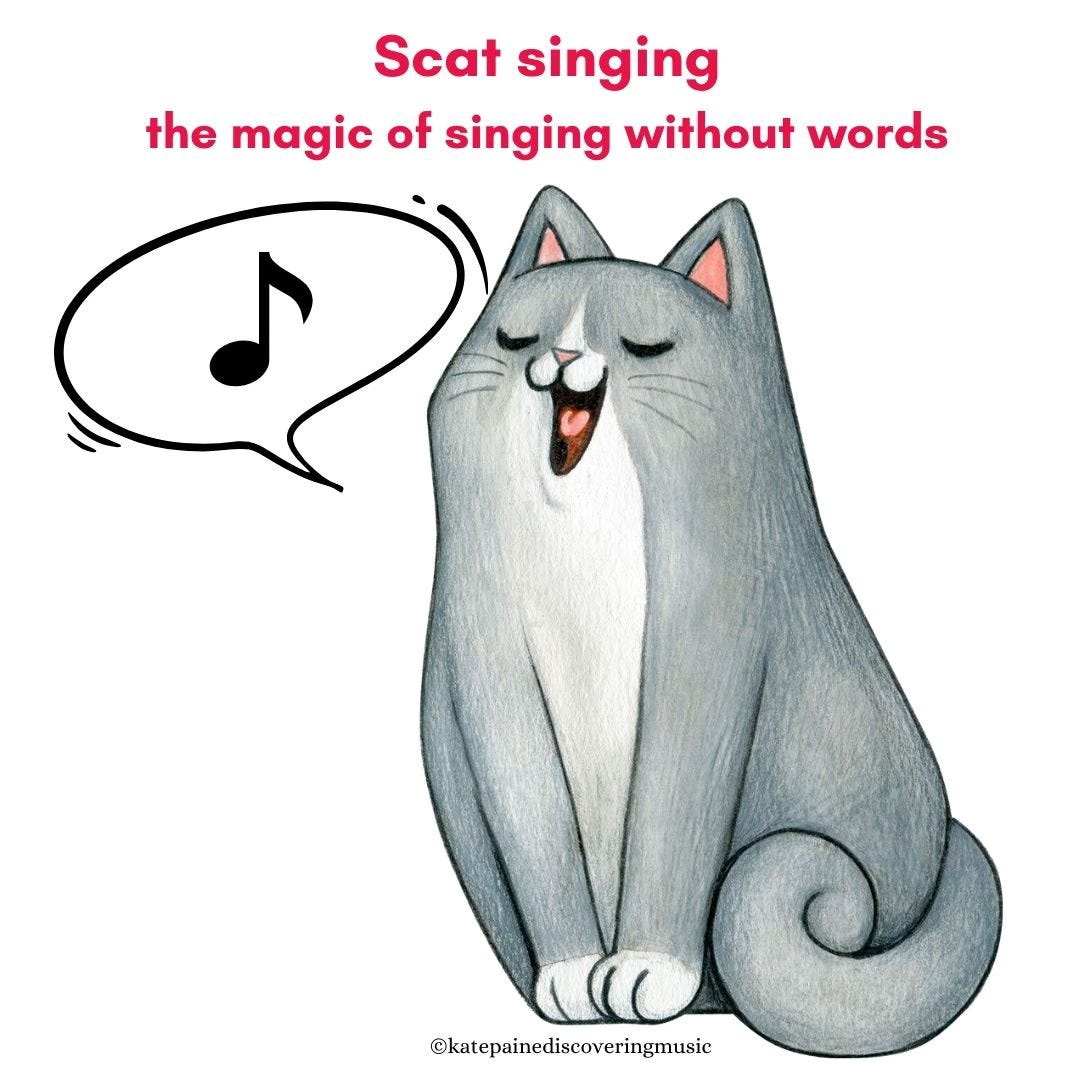Doo bee doo bee doo
Scat singing: the magic of singing without words and turning sounds into song.
A couple of weeks ago I mentioned my annoying inability to remember lyrics, a bit of a disadvantage when you’re regularly getting up in front of people to sing! (For more on how the brain works, go to Singing your way to good brain health).
This week (and with thanks to Natalie W for the idea 💜), I thought I’d talk about how for singers there’s a handy alternative to actual words—because who needs them, right?—and that’s scat singing.
Scat singing is when a singer emulates an instrument, like a saxophone, trumpet, or trombone, in order to improvise a melody and rhythm over the harmonic changes in a song. In other words, the song keeps on going underneath and the singer makes up something over the top.
Of course, singers can already play around with a song—changing the melody, rhythm, and phrasing— even when they’re singing the words, but doing away with them altogether means a singer is no longer tied to matching notes to the words, and so there’s a greater freedom of movement and expression.
Instead of words, sounds and syllables are used to mimic the articulation of an instrument. Articulation is all about the attack of the notes (how they start), their release (how they finish), and how they’re sustained (how they sound in the middle of the note).
Articulation works as part of a team with the rhythm, the melody, and the syllables. It’s a package deal that a singer puts together to get the sound and music they want.
There’s more to it, of course (and for more on the history you can read this and this), but here’s a few examples of sounds/syllables that are great for imitating instruments and providing a range of different feels:
Doo Bah
Dah Shoo
Bee Bop
La Dee
Dat Zi
Za Zoo
Some of these sounds, like Bop, naturally have a harder attack and are more percussive than others, while some, like Shoo, are great for longer notes and softer attacks. It really depends on the nature of the song, and whatever helps the singer create something free-flowing and spontaneous when they’re in the middle of making something up (improvising).
A good understanding of jazz harmony, rhythm, and phrasing is definitely helpful when trying scat singing and, as with everything to do with music, the more you listen to others and to instrumental solos, as well as practicing it yourself, the easier it will become.
Want to try singing without words for yourself?
But even without knowing anything there’s nothing stopping you from trying it out for yourself. Here are some simple things you can do to see what it feels like to let go of the words when singing:
To begin with, it’s worth getting used to the idea of saying syllables instead of words.
Tap out a simple beat (1, 2, 3, 4) with your hands on a hard surface (table, knee, head!), and experiment with matching syllables to the beat.
Start with simple sounds like Da, Ba, Doo. When you feel comfortable with this, try varying the rhythm you’re saying (or singing) while still tapping, and try introducing more combinations of sounds. For example: Dah-bah, Doo-bee, Zi-Za, Shoo-bee.
Choose a simple melody you know well. It could be Happy Birthday or Mary Had a Little Lamb, or anything at all.
Sing the melody and substitute different sounds for the words.
For example, instead of singing Mary Had a Little Lamb, try: Doo Ba Da Doo Shoo Da Bop, or whatever combination of sounds speaks to you!
You can experiment with the emphasis you put on notes, making some notes much harder (Bop!) or softer (Shoo), and with combinations of sounds.
And look! I made a video to show you exactly what I mean:
If you want to take it further, look for some backing tracks on YouTube or whatever streaming service you use, and see what you can come up with. Keep it simple at first, and remember that the more you do it the easier—and less silly—it (and you) will feel.
Most important of all is to remember there is no right or wrong. It’s all about expression and telling a story, despite the lack of words (and for more on music and storytelling, go to Tell me a story).
Ditching the words and choosing your own sounds means you get to help set the mood and guide the music/story any way you want.
And finally, I’m going to leave you with some of my favourite scat singers. There are so many but Ella Fitzgerald is undoubtedly the queen. In this 1960 performance of Mack the Knife she also forgets the words, makes some up on the spot, and then does an incredible scat solo (my hero!):
And here’s the amazing Sarah Vaughan, smooth as anything, with All of Me:
Let me know if you enjoyed this post! And let me know if there's anything you're curious about or would like me to explore further. You can comment on this post or send me a message at katepainediscoveringmusic@substack.com ❤️




